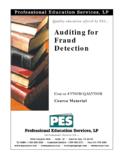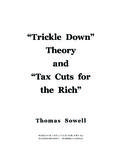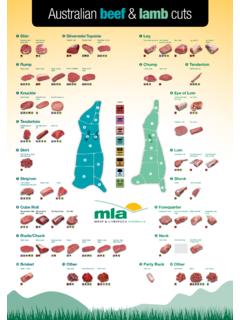Transcription of Summary of the Tax Cuts and Jobs Act - CPA CPE
1 Summary of the Tax cuts and jobs ActSigned into law December 22, 2017 1 TAX cuts AND jobs ACTHOUSE AND SENATE CONFERENCE COMMITTEEP lease Note: This Summary has been adapted from the House and Senate Conference Committee and other sources. It does not reflect any views or opinions of Professional Education Services, HIGHLIGHTS:The Tax cuts and jobs Act (TCJA) ( 1) overhauls America s tax code to deliver tax relief for workers, families, and job creators. By lowering taxes across the board and modernizing our international tax system, the Tax cuts and jobs Act will help create jobs , increase paychecks, and make the tax code simpler for Americans of all walks of INDIVIDUALS AND FAMILIES, THE TAX cuts AND jobs ACT: Lowers individual taxes and sets the rates at 0%, 10%, 12%, 22%, 24%, 32%, 35%, and 37%.
2 Significantly increases the standard deduction to protect roughly double the amount of what you earn each year from taxes - from $6,500 and $13,000 under current law to $12,000 and $24,000 for individuals and married couples, respectively. Continues to allow people to write off the cost of state and local taxes - up to $10,000. Gives individuals and families the ability to deduct property taxes and income - or sales - taxes to best fit their unique circumstances. Eliminates many itemized deductions. The new tax law eliminates itemized deductions for: Unreimbursed employee expenses, such as mileage (currently deductible to the extent they exceed 2% of adjusted gross income) Tax preparation expenses Alimony payments Investment expenses Moving expenses to move to a new job, and Personal casualty losses (except for losses associated with special disaster relief legislation).
3 Charitable contributions remain deductible by itemizers. People who itemize will be allowed to deduct cash contributions up to 60% of their adjusted gross income, instead of 50% under current law. 2 Takes action to support more American families by: Expanding the Child Tax Credit from $1,000 to $2,000 for single filers and married couples to help parents with the cost of raising children. The tax credit is fully refundable up to $1,400 and begins to phase-out for families making over $400,000. Parents must provide a child s valid Social Security Number in order to receive this credit. Preserving the Child and Dependent Care Tax Credit to help families care for their children and older dependents, such as a disabled grandparent who may need additional support.
4 Preserving the Adoption Tax Credit so parents can continue to receive additional tax relief as they open their hearts and homes to an adopted child. Preserves the mortgage interest deduction - providing tax relief to current and aspiring homeowners. For all homeowners with existing mortgages that were taken out to buy a home, there will be no change to the current mortgage interest deduction. For homeowners with new mortgages on a first or second home, the home mortgage interest deduction will be available up to $750,000. Provides relief for Americans with expensive medical bills by expanding the medical expense deduction for 2017 and 2018 for medical expenses exceeding percent of adjusted gross income, and rising to 10 percent beginning in 2019.
5 Continues and expands the deduction for charitable contributions so people can continue to donate to their local church, charity, or community organization. Maintains the Earned Income Tax Credit to provide important tax relief for low-income Americans working to build better lives for themselves. Improves savings vehicles for education by allowing families to use 529 accounts to save for elementary, secondary, and higher education. Provides support for graduate students by continuing to exempt the value of reduced tuition from taxes. Retains popular retirement savings options, such as 401(k)s and Individual Retirement Accounts (IRAs) so Americans can continue to save for their future.
6 Increases Alternative Minimum Tax relief. The TCJA increases the amount of income exempt from the Alternative Minimum Tax by 39%. As a result, fewer taxpayers will be subject to the AMT. 3 Adjusts estate taxes. Under the TCJA, estates worth up to $11 million per person are exempt from the federal estate tax, double the prior amount. This means that married couples with estates worth up to $22 million will not be affected by the federal estate tax. Repeals Obamacare individual tax penalty. The Affordable Care Act (popularly called Obamacare) required individuals to obtain minimally adequate health insurance for themselves and their dependents.
7 Those that failed to comply had to pay a tax penalty to the IRS. The TCJA permanently eliminates this penalty starting in 2019, effectively making individual compliance with Obamacare purely voluntary. However, the penalty remains in effect for JOB CREATORS OF ALL SIZES, THE TAX cuts AND jobs ACT: Lowers the corporate tax rate to 21% (beginning January 1, 2018) - down from 35%. Delivers significant tax relief to Main Street job creators by: Offering a first-ever 20% tax deduction that applies to the first $315,000 of joint income earned by all businesses organized as S corporations, partnerships, LLCs, and sole proprietorships.
8 For Main Street job creators with income above this level, the bill generally provides a deduction for up to 20% on business profits - reducing their effective marginal tax rate to no more than Establishing strong safeguards so that wage income does not receive the lower marginal effective tax rates on business income - helping to ensure that Main Street tax relief goes to the local job creators it was designed to help most. Increases Section 179 expensing. Increases the Section 179 maximum annual deduction limit to $1 million from $500,000, and increases the phase-out threshold to $ million from $2 million starting in tax year 2018.
9 Increases bonus depreciation. Increases to 100% the first-year bonus depreciation percentage (from the current 50% rate) for long-term assets placed in service after September 27, 2017. Allows bonus depreciation to be used for purchases of used property, as well as new property. Computers no longer listed property. Computers are no longer classified as listed property starting in tax year 2018. Protects the ability of small businesses to write off interest on loans, helping these Main Street entrepreneurs start or expand a business, hire workers, and increase paychecks. 4 Preserves important elements of the existing business tax system, including: Retaining the low-income housing tax credit that encourages businesses to invest in affordable housing so families, individuals, and seniors can find a safe and comfortable place to call home.
10 Preserving the Research & Development Tax Credit that encourages our businesses and workers to develop cutting-edge Made in America products and services. Retaining the tax-preferred status of private-activity bonds that are used to finance valuable infrastructure projects. Eliminates entertainment and meals deduction. Eliminates deductions for entertainment and meal expenses starting in tax year 2018. Businesses may still deduct 50% of cost of food consumed by employees during work or travel. Eliminates the Corporate Alternative Minimum Tax, thereby lowering taxes and eliminating confusion and uncertainty so American job creators can focus on growing their business and hiring more workers, rather than on burdensome paperwork.












